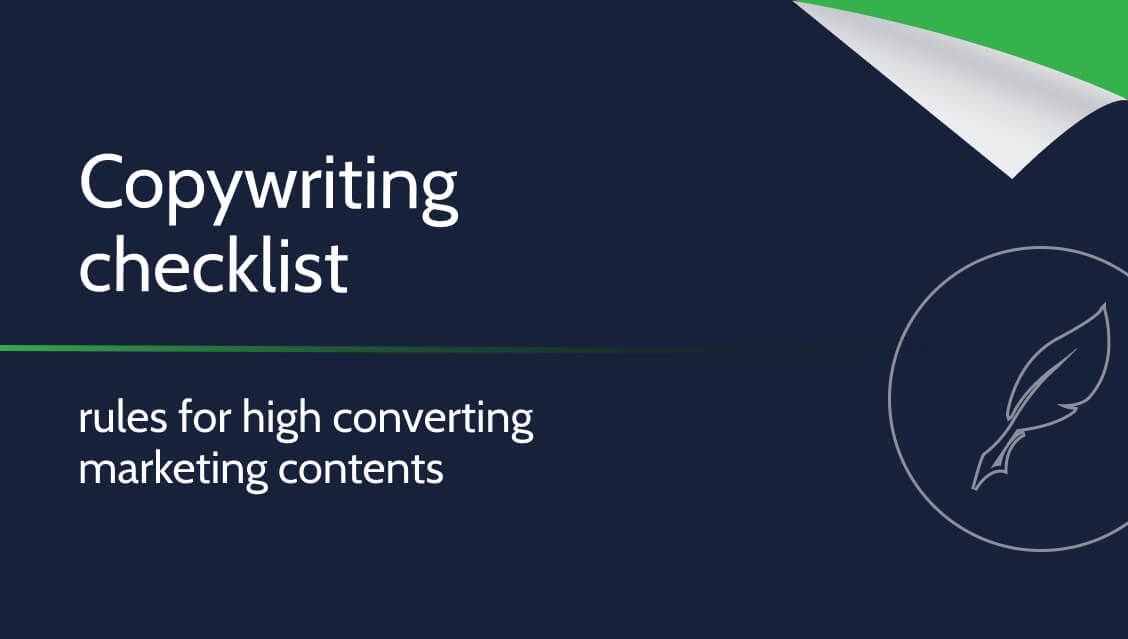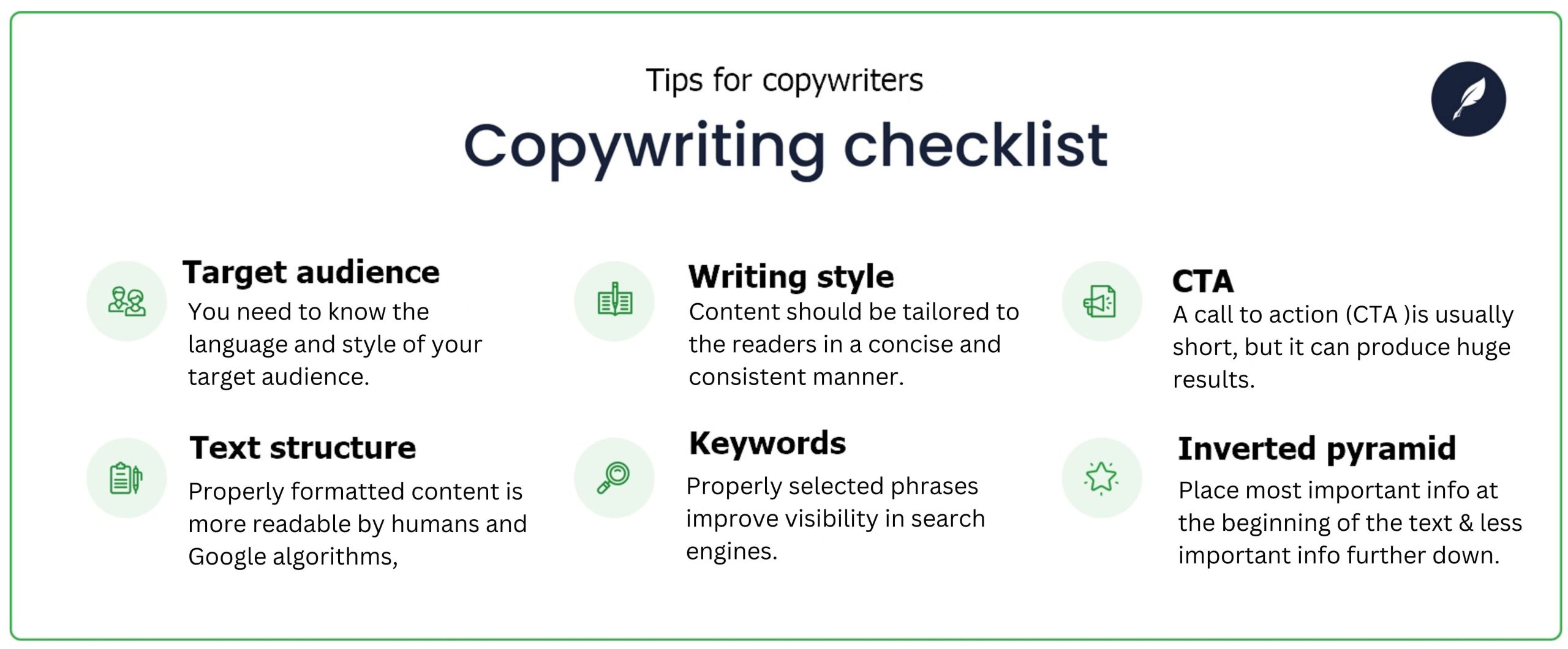Copywriting checklist – rules for high converting marketing contents

Copywriting is all about creating contents that meet certain requirements. The contents are not only expected to meet the expectations of the client, but also, to evoke a specific reaction among readers. However, writing texts that achieve high conversion rates requires following certain rules. Read this copywriting checklist and find out what aspects of copywriting are most important.
What is copywriting checklist?
Copywriting checklist is a list of points and tips that are most important when creating marketing contents.
The copywriter creates texts that allow the client to achieve the intended marketing goal. The content should first of all interest the recipient and in certain cases make him perform a specific action, e.g.
- make a purchase,
- subscribe to the newsletter,
- send an inquiry.
The purpose of contents created by copywriters can also be to build a brand image, educate readers or increase website traffic. In these cases, blog articles will be perfect, as they usually do not encourage the purchase, but create the image of an expert and bring answers to bothering users’ questions, which in turn may translate into conversions.
See also
Copywriting checklist – a list of tips for a copywriter
Creating effective texts requires knowing and following certain rules. On our copywriting checklist you will find the most important tips regarding form and content.

Target audience
Knowing the target group is one of the most important conditions for creating an effective text. We put this rule at the top of a copywriter’s checklist because it should be the foundation of your writing.
Of course, you can try to write for everyone, but unfortunately there is a high probability that such texts will not reach anyone. Therefore, if you want your work to bring the expected results, you need to know who you are writing for. This will allow you to adjust the language and way of writing to the expectations of the recipient. The needs of a marketing persona, i.e. a potential consumer, supplicant or service recipient, are the basis for creating quality content.
Text structure
The proper structure of the text is essential for its effectiveness. Valuable content reaches a larger number of recipients not only because it is read more willingly and recommended more often, but also because it achieves high positions in the Google search engine. Good positioning can therefore be both the goal and the effect of content creation.
Users and search engine algorithms use slightly different criteria when evaluating web contents. However, you can stick to a few rules (listed below) regarding the structure of the text that will increase the chances of a positive rating from both sides.
- Use headlines – Headings (usually H1-H4, rarely H5 and H6) organize the content, giving a specific hierarchy to individual fragments of text. They also make it easier for users to navigate through the article and find specific information.
- Use paragraphs – Short paragraphs make the content clearer and easier to find specific information in it. Ideally, one paragraph should contain one thought.
- Use bullets – Bullets allow you to present content in a visually attractive form. Replacing many elements after a comma, in turn, promotes the creation of the so-called. walls of text and impairs the reception of the message.
- Add table of contents – Thanks to the table of contents, the recipient has a chance to quickly find out what topics are discussed in the text. It is also a chance to keep the user on the site.
- Use the inverted pyramid principle – The most important information should be at the beginning and less important information later. If the recipient finds what interests him in the first sentences, there is a good chance that he will stay on the page to learn more.
- Remember the introduction, development and conclusion – The introduction (lead) is supposed to present the content in a nutshell and encourage the user to read the whole thing. The development is the proper part of the article, containing substantive value. The conclusion is a summary of the whole, a summary of the most important information presented in the text.
- Pay attention to the graphic design – A visually attractive message attracts attention and improves reception. Therefore, in addition to the structure of the text, it is worth taking care of the images, charts and infographics used.
- Add meta tags – A catchy title and an interesting description can determine the success or failure of your text. Meta tags should contain keywords and encourage users to visit the page.
See also
Writing style
The style should be adapted to the target group. After all, you will write a text addressed to teenagers differently than one intended for seniors. Regardless of the client, however, you must remember a few most important rules.
- Write concisely – Avoid the so-called pouring water, i.e. writing that is not specific and avoids the heart of the matter. Try to condense the thoughts that you put on a piece of paper as much as possible.
- Try to use simple language – If you’re not writing for experts, make your content understandable to a wide range of readers. Therefore, use short sentences and explain specialist terms, e.g. in parentheses.
- Avoid the word “no” – “No” is associated with bans and has a pejorative connotation. In addition, there is a risk that the user will miss the “no”, which will completely change the meaning of the sentence being read. Therefore, instead of phrases that are supposed to dissuade readers from a certain action, use those that are supposed to encourage them to do the opposite. Instead of writing “do not avoid responsibility”, write “take responsibility”.
- Use active instead of passive sentences – The active page is easier to read. Therefore, if possible, try to avoid the passive voice and instead of formulating a sentence like this: “The law was passed by the deputies”, write: “The deputies passed the act”.
- Remember the consequences – Stick to a specific style, address, and text formatting. Your text will be consistent and more pleasant to read when you implement this tip and others listed above.
Keywords
Properly-selected keywords allow the recipient to find their way to your article. It is these phrases that the user enters into the search engine. Their selection and skillful use in the text is an inseparable element of copywriting.
Keywords are sometimes single words, but more often they consist of two words (e.g. copywriting checklist) or a whole group. Due to the length, they can be divided into 3 types:
- Fat head phrases: short, contain 1-2 words;
- Chunky middle phrases: usually consist of 3 words;
- Long-tail phrases: contain 4 or more words.
Thanks to the appropriate programs (e.g. Ahrefs, Keyword Planner or Senuto) you can independently determine the keywords with the highest potential, i.e. find phrases that are most often entered into the Google search engine. In the work of a copywriter, however, you usually receive information about them from the client along with other guidelines regarding the order.
CTA
A call to action is a short phrase, usually placed at the end of the text, that urges the reader to take a specific action. It can be a subscription to the newsletter, making a purchase or even leaving a comment under the article.
It is a solution that often brings great results with a small amount of work – a response to a CTA can transform the reader of your written content into a customer.
Inverted pyramid
The inverted pyramid style of writing is a copywriting technique that prioritizes the delivery of crucial information at the beginning of an article, followed by supporting details and background information in descending order of importance.
The concept is rooted in the idea that readers often have limited time or attention span, and by presenting the most significant facts upfront, the essential message can be quickly communicated.
This writing style aims to allow readers to grasp the key points immediately. The inverted pyramid style emphasizes concise and direct language, ensuring that readers receive the most critical details first while still providing additional context for those who continue reading.
Summary
- The copywriting checklist is a list of the most important rules that a copywriter should follow when writing marketing contents.
- They primarily relate to the target audience, text structure, style, keywords and CTA.
- Knowing and following the rules on the copywriting checklist is an important element of creating marketing content.

















Leave a Reply